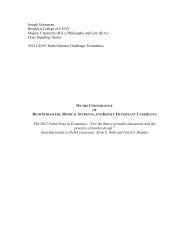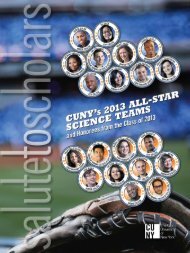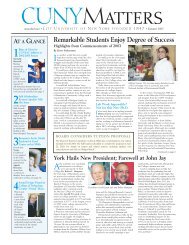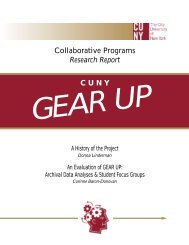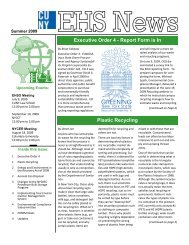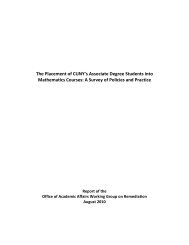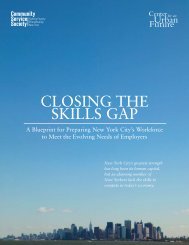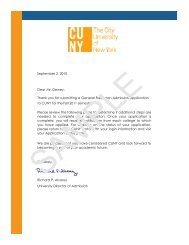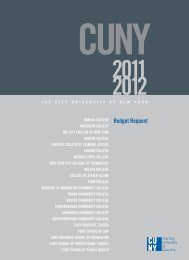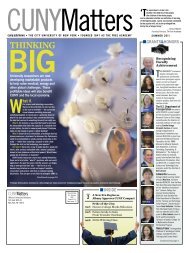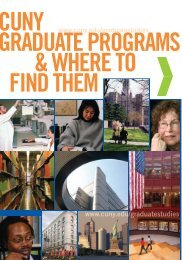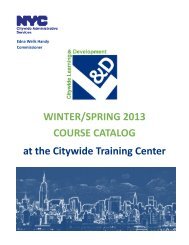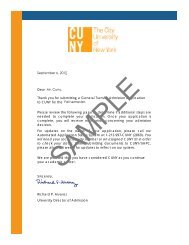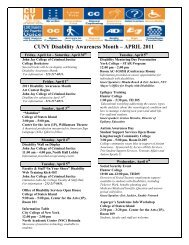CUNY Master Plan 2012-2016
CUNY Master Plan 2012-2016
CUNY Master Plan 2012-2016
Create successful ePaper yourself
Turn your PDF publications into a flip-book with our unique Google optimized e-Paper software.
THE <strong>CUNY</strong> MASTER PLAN <strong>2012</strong>-<strong>2016</strong><br />
in applied research with ties to industry will receive increased research funding from private companies,<br />
and there will be greater involvement, donations, and investment by alumni in the University. Recruitment<br />
of top-notch faculty will become easier as productive researchers, who are interested in commercializing<br />
their inventions, will be attracted to <strong>CUNY</strong>. University-industry collaboration will also<br />
encourage the creation of startup companies that will both generate a new source of revenue for <strong>CUNY</strong><br />
and have a positive impact on local economies. Faculty working with private companies will be able revitalize<br />
career-oriented graduate programs and contribute to the development of new professional programs.<br />
Opportunities for student involvement in internship and research programs in the private sector<br />
will increase, thus enhancing <strong>CUNY</strong>’s ability to expand career prospects for its graduates, and consequently<br />
increasing student recruitment and retention.<br />
In its initial phase, the core function of the center will be as a business incubator for <strong>CUNY</strong> faculty—<br />
offering its tenants a physical infrastructure, professional mentorship, opportunities for collaboration,<br />
and a host of supportive and administrative services. The Center will have a <strong>CUNY</strong>-wide scope and will<br />
embrace entrepreneurship in science and engineering as well as in non-science based companies. The<br />
Center will initially occupy approximately 6,000-10,000 square feet at an external commercial site, and is<br />
expected to house between 15-25 companies when fully operational.<br />
This Center will integrate several existing University-wide services that facilitate entrepreneurship,<br />
including technology transfer, intellectual property, and legal assistance, as well as research administration.<br />
The <strong>CUNY</strong> Technology Commercialization Office will provide direct support on issues related to<br />
technology transfer, agreements and contracts, and licensing to Center tenant companies. Such integration<br />
of different functional domains is vital for creating an effective system capable of expediting legal<br />
and financial transactions with investors, companies and the business community.<br />
This initiative recognizes the need to establish a <strong>CUNY</strong> Innovation and Entrepreneurship Fund. This<br />
fund will be used to attract external financial support for <strong>CUNY</strong>’s efforts in generating, sponsoring,<br />
and/or incubating companies. Such a fund would provide an excellent mechanism for creating and developing<br />
interest among alumni and other private investors. <strong>CUNY</strong> will leverage internal resources to set up<br />
this fund and help raise external resources.<br />
<strong>CUNY</strong>’s strength has always been in the talent and expertise of its faculty. In scaling up innovation and<br />
entrepreneurship, <strong>CUNY</strong> will be broadening the University’s rich tradition of research that benefits the<br />
colleges and the University, as well as the local and state economies.<br />
Educating Teachers and Early Childhood Educators for New York<br />
As is well known, <strong>CUNY</strong> occupies a historic place as a training-ground for New York’s teachers. Currently,<br />
pressing questions are being raised on the quality of teacher education programs across the<br />
nation. These challenges have been largely fueled by two issues: (1) persistent achievement gaps (disparities<br />
in performance on achievement measures) across white and black students, wealthy and poor students,<br />
and U.S. versus non-U.S. students (in terms of international comparisons); and (2) the fact that a<br />
large percentage of students graduate from high school unprepared to do college-level work.<br />
74



